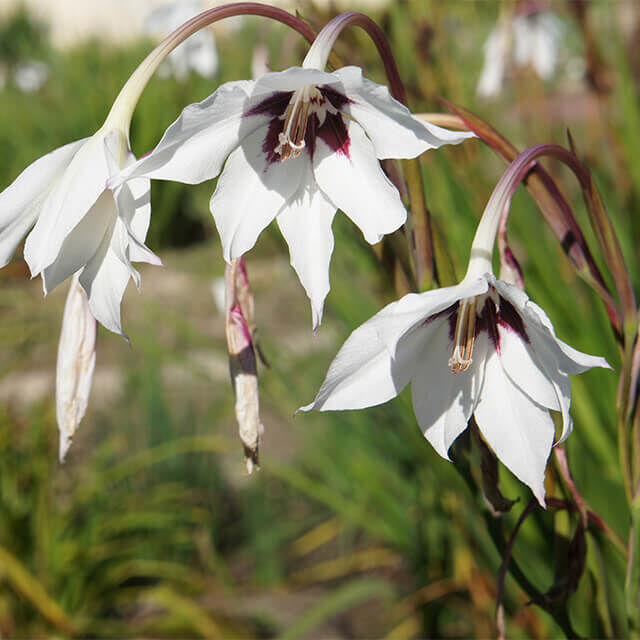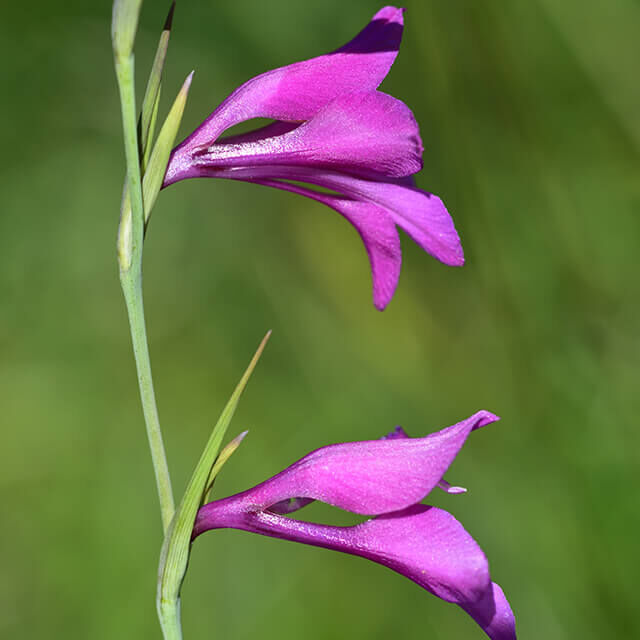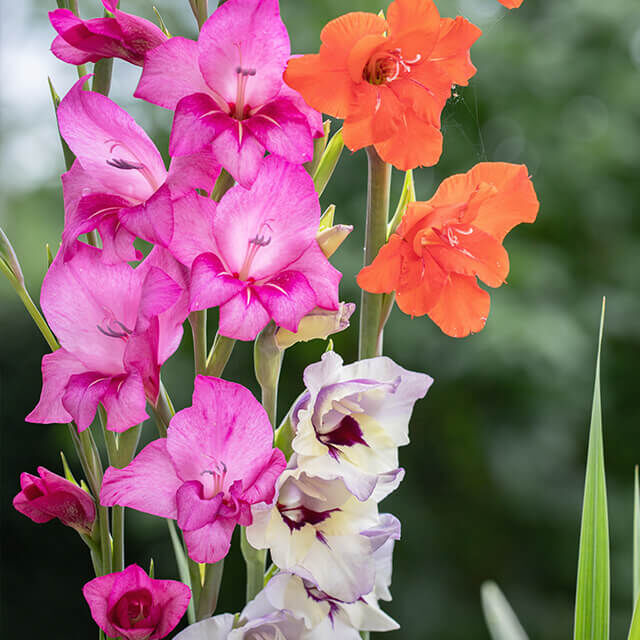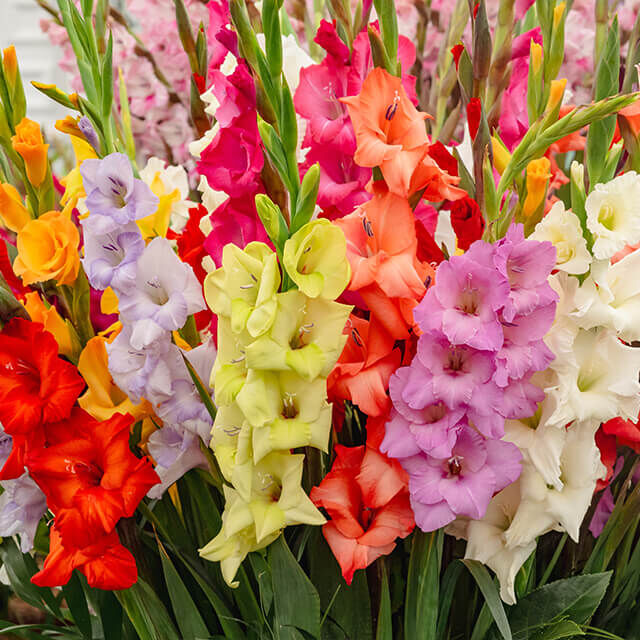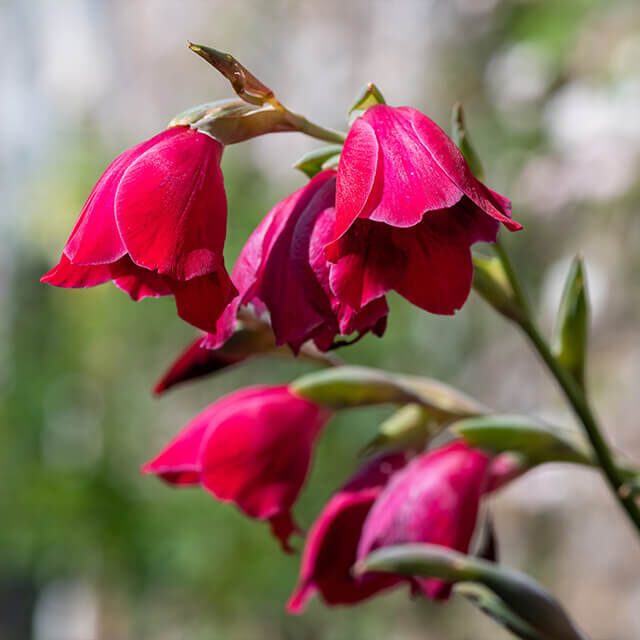Planting and caring for gladioli: Your ultimate guide to gorgeous sword flowers

Gladioli – also known as sword flowers – are among the most impressive summer flowers in the garden and in the vase. With their upright, long stems and bright inflorescences, they make a powerful statement. Whether in a flower bed, as a gladiolus bouquet or as a birth flower in August, this flower impresses with its diversity and symbolic power. In this guide, you will learn everything about planting, caring for and the meaning of gladioli – and how you can enjoy their beauty all year round.
What are gladioli?
The gladiolus belongs to the iris family. It is characterised by its sword-shaped leaves and impressive flower spikes. Depending on the variety, it can reach a height of 50 to 150 centimetres. Gladioli are perennial, but in our latitudes they are usually cultivated as summer flowers because they are not completely winter hardy.
What other names are gladioli known by?
In addition to the botanical name Gladiolus, the names sword flowers and gladioli are also common. Subspecies such as the star gladiolus and the Abyssinian gladiolus also have their own common names.
What is the significance of the gladiolus?
Since ancient times, the gladiolus has symbolised strength, pride and admiration. It owes its name to the Latin word gladius (= sword).
What does giving gladioli as a gift mean?
A bouquet of gladioli symbolises admiration, honesty and strength of character. It is perfect for expressing respect and appreciation – whether as a thank you or as congratulations on a special occasion.
Birth flower for August
The gladiolus is the birth flower for August. With its majestic flower spikes, it is perfect for this summer month when nature is in full bloom. Those born in August are considered confident, passionate and determined – qualities that are also reflected in the proud stance of the gladiolus. A bouquet of gladioli is therefore a wonderful gift for those born in August to express admiration and appreciation.
Profile
- Genus and origin: Over 250 species originate from Africa, the Mediterranean region and the Near East.
- Appearance and growth: Slender stems with sword-shaped leaves and colourful flowers.
- Location: Sunny and sheltered from the wind.
- Soil: Loose, nutrient-rich and well-drained.
- Flowering period: July to September – depending on planting time.
- Gladiolus leaves: The leaves of the gladiolus are sword-shaped, grow upright and give the plant its name – hence the name sword flower. They appear shortly after the tuber sprouts and perform an important task: the leaves collect nutrients and energy, which are stored in the tuber. Therefore, gladiolus leaves should not be removed immediately after flowering, but only once they have completely wilted and yellowed. This ensures that the tubers have enough energy for the next season and will bloom profusely again the following year.
What types of gladioli are there?
There are numerous types of gladioli – from delicate wild varieties such as the field gladiolus and marsh gladiolus to magnificent cultivated varieties such as butterfly gladioli, dwarf gladioli and star gladioli – which vary greatly in colour, size and possible uses.
There are both wild varieties and numerous cultivated varieties of gladiolus:
Wild varieties: field gladiolus, marsh gladiolus, Abyssinian gladiolus, dwarf gladiolus.
Cultivated varieties/breeds: butterfly gladiolus, star gladiolus and many other hybrids in different sizes and colours – from pure white to bright red to two-tone varieties.
Gladioli impress with an incredible variety of colours and sizes. Their palette ranges from delicate pastel shades such as white, cream or pink to bold colours such as yellow, orange, red or purple. Many varieties also surprise with two-tone or patterned flowers that make every flower bed and bouquet a real eye-catcher. The species also differ significantly in height: while compact dwarf gladioli only grow to around 40 to 60 centimetres, large-flowered cultivars with impressive flower spikes reach an impressive 150 centimetres.
What are particularly popular varieties or cultivars for gardens and cut flowers?
Planting & Care
Gladioli are planted in beds or pots from May onwards, once there is no longer any risk of frost. Depending on the variety and desired flowering time, you can plant the gladiolus bulbs in stages – i.e. at intervals of two to three weeks. This will extend the flowering period throughout the summer until September.
Gladioli bulbs should be planted about 10 to 15 centimetres apart. This gives the plants enough space to develop and form their impressive flower stems.
Gladioli thrive in flower beds, large pots or even raised beds. It is important that the location is sunny, sheltered and well-drained so that the bulbs do not stand in waterlogged soil.
Gladioli love the sun and need at least six hours of direct sunlight per day. As their long stems are susceptible to wind, it is advisable to choose a location that is somewhat sheltered from the wind or to secure the plants with support sticks if necessary.
Loose, humus-rich soil that drains well is ideal. Waterlogging should be avoided at all costs. The pH value should be neutral to slightly acidic. Nutrient-rich soil promotes strong flowers and healthy growth.
After planting the corms, the first gladioli leaves usually appear after two to three weeks. Depending on the weather, this can happen a little faster or slower.
During the growth phase, gladioli need to be watered regularly. You should water them thoroughly, especially in dry summers. However, make sure that no waterlogging occurs.
Yes, gladioli respond well to regular fertilisation, as they need a lot of energy for their long flower stems.
A slow-release fertiliser is best when planting, combined with occasional applications of liquid fertiliser during the growth and flowering period. A low-nitrogen flower fertiliser particularly supports flower formation.
After flowering, the wilted inflorescences should be removed. However, leave the leaves until they have completely died back. This allows the corms to gather new energy for the next season.
Only when the gladioli leaves have turned yellow and dried out should you cut them back to ground level. The corms should be dug up, dried and stored in a cool, frost-free place before the first frost at the latest.
Can gladioli be left in the ground? In our latitudes, it is generally not advisable to leave gladioli in the ground as they are not completely hardy. The corms would freeze in frost and would not sprout again the following year. However, if you still want to try overwintering gladioli in the ground, you should plant them in a particularly sheltered, mild location and cover them with a thick layer of leaves or brushwood. However, it is safer to dig up the corms in autumn, dry them and store them frost-free so that they can sprout again healthily the following spring.
It is best to store gladiolus bulbs in a cool, dry and dark place after digging them up. To do this, thoroughly remove any soil and dead leaves and leave the corms to dry for a few days. You can then wrap them in dry soil, sand or newspaper in a box. It is important that they are well ventilated to prevent mould from forming. At a storage temperature of around 5 to 10 degrees, the bulbs will remain healthy until spring and sprout again reliably.
Gladiolus tip: Why removing the top bud is a good idea
Removing the top bud on gladioli is a common care tip if you want particularly large and strong flowers. The plant then does not put its energy into all the buds at once, but concentrates on the side flowers. This causes them to open faster and often appear larger and more intense in colour. This can be particularly useful for cut flowers in vases, as the inflorescences appear more uniform and decorative. Important: Cut the bud carefully with clean scissors or a sharp knife so as not to damage the plant.
Uses and DIY ideas
Cut flowers: Gladioli are classic cut flowers with a vase life of up to two weeks.
Decoration: Individually in tall vases or combined in lush arrangements – perfect for summer parties.
DIY: You can also find creative ideas for gladioli in our DIY ideas section.
Gladioli are best cut when the lowest flowers have already opened, while the upper buds are still closed. This allows the flowers to unfold gradually and the gladioli bouquet to last particularly long. It is best to cut the stems early in the morning or late in the evening when it is cooler.
Cut the stems at an angle with a sharp knife so that they can absorb more water. Place them in lukewarm water immediately and change the water regularly. Gladioli are ideal for tall vases and can be beautifully combined with other summer flowers such as sunflowers or roses. If you want to achieve a particularly elegant effect, display them on their own – this really shows off their upright shape.
DIY decoration ideas with gladioli
Gladioli are not only a highlight in bouquets, but also versatile in decoration. They look particularly elegant when arranged individually in narrow glass vases, placed in a row on the table. They are also ideal as eye-catchers in large floor vases or as lavish arrangements for celebrations. You can also find creative inspiration in our DIY ideas.
Propagating gladioli
Gladioli can be propagated using corms. These usually take two to three years to reach flowering stage. Tip: Divide old corms regularly and replant the strongest specimens.
Gladioli form corms over time. After flowering and before storing, you can carefully separate the old corms from the small cormettes. It is important to keep only the strongest specimens for the next season. This will rejuvenate your stock and ensure healthy plants with abundant flowers.
The small daughter corms require patience: it usually takes two to three years for them to grow large enough to form flowers. During this time, they initially only form leaves, but gather strength for the coming years.
Yes, gladioli can also be planted in pots or tubs. Particularly compact varieties such as dwarf gladioli are suitable for this. It is important that the pot is deep enough to support the long stems and that excess water can drain away easily. They make a colourful summer companion on the balcony or terrace.
Frequently asked questions about gladioli
Depending on when they are planted, gladioli bloom from July to September. If you plant the corms at different times, you can enjoy the colourful flowers for many weeks.
A fresh bouquet of gladioli usually lasts 7 to 14 days in a vase. The flowers open gradually from the bottom up, so the vase remains decorative for a long time.
To keep gladioli fresh for a particularly long time, cut the stems at an angle and place them in lukewarm water immediately. Change the water regularly and remove wilted flowers. A location without direct sunlight and draughts will also extend their shelf life.
Yes, it is advisable to remove the top bud from gladioli. This allows the plant to concentrate its energy on the flowers below, which will then bloom more vigorously and evenly. Especially in the case of gladioli that are cut for vases, this makes the flower stem look more harmonious and keeps it fresh for longer.
Gladioli grown in pots can be dug up after the leaves have wilted and the corms stored in a cool, dark and frost-free place. If you want to leave them in the pot, place it in a sheltered spot in the cellar or garage so that the gladioli bulbs are protected from frost.
Yes, gladioli are considered slightly poisonous. Parts of the plant can be harmful, especially to pets such as cats and dogs. The corms are also not suitable for human consumption.
Yes, the gladiolus belongs to the iris family (Iridaceae). It owes its name to the sword-shaped leaves that are typical of this plant family.
If gladioli do not form flowers, this is usually due to insufficient nutrients, a location that is too shady or immature tubers. Waterlogging can also impair development.
If the stems are limp, support sticks can be used to prop up the tall flowers. Damage to the leaves can be caused by pests such as thrips or fungal diseases. Affected leaves should be removed and the plant treated if necessary.
Gladioli can be affected by leaf spot diseases, thrips or rot. Regular checks and an airy location prevent problems.
The gladiolus is a true queen among summer flowers: majestic, colourful and full of meaning. Whether in the garden, in a vase or as a gift, it enchants with its elegance and symbolic power. With the right care, you will enjoy it for a long time. Discover more inspiration in our flower species blog or browse through our summer flower ideas.














